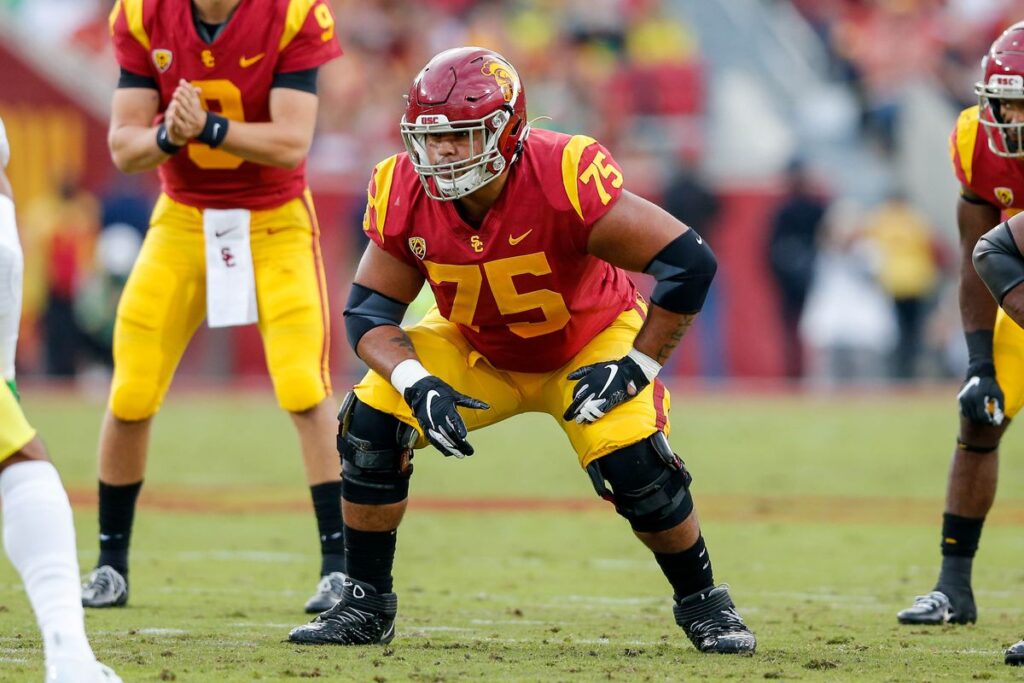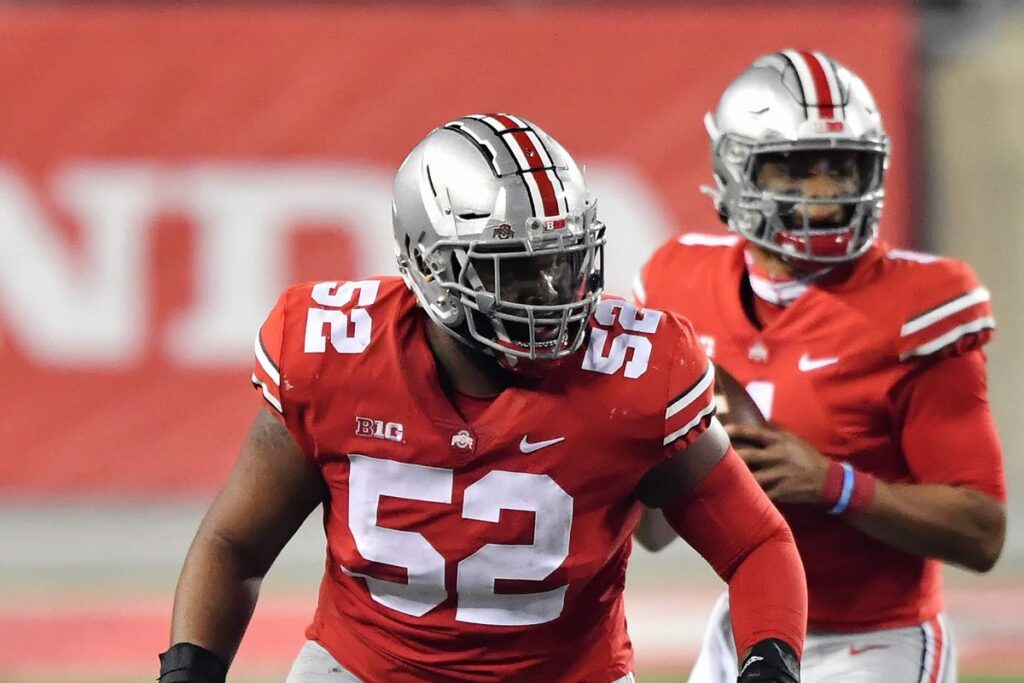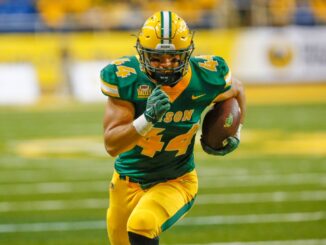This year’s interior offensive line class might not have a standout, top 15 prospect, but there are definitely quality players available. There will be some debate about where these players fit best – Vera-Tucker could play tackle, whilst the likes of Dickerson, Meinerz, and Green all offer center/guard flexibility – but they can all make an immediate impact on an NFL roster in 2021. Here are my top ten interior offensive linemen in the 2021 Draft.
1. Alijah Vera-Tucker – USC

Pros: Vera-Tucker is first and foremost an excellent run blocker. He is consistently able to create movement up front, sustaining his blocks very well and playing with great balance. When it comes to pass protection he is very effective and is rarely beaten one-on-one. Vera-Tucker allowed just 16 pressures across his 975 career pass blocking snaps at USC. Almost a third of these snaps came at left tackle and he looked pretty comfortable there in 2020. He’s a smart player too, and does a good job of reading and reacting to stunts and blitzes. Vera-Tucker is a day one starter along the interior, with tackle flexibility.
Cons: Vera-Tucker lacks the prototypical length that you want in a tackle and his struggles against Kayvon Thibodeaux in the Oregon game will be a concern. His struggles in getting depth out of his stance can also leave him vulnerable to speed rushers, and this is partly the reason many view him as a guard in the NFL. Vera-Tucker lacks ideal hand strength for an interior lineman and his technique can be a little hit and miss. He has a tendency to use a wide grip and needs to do a better job of establishing control inside his opponent’s frame. He also lacks ideal anchor strength and can struggle when opponents out-leverage him.
Projection: 1st round
2. Landon Dickerson – Alabama

Pros: Dickerson is a huge player who has all of the strength and power you could ask for in an offensive lineman. He offers positional versatility, having started out as a guard at Florida State, before playing center at Alabama. Dickerson did everything that was asked of him in a versatile Alabama blocking scheme and he has all of the technical tools to translate well to the NFL. His tape as a run blocker is particularly impressive and he led the nation with 14 big-time blocks in 2020. He plays the game with a real mean streak and is clearly a tough competitor. He took kneel-down snaps in the national championship game after tearing his ACL just three weeks earlier.
Cons: Dickerson is one of the most polished prospects in this class but his injury history is a major concern. He has suffered two torn ACLs, as well as numerous ankle injuries and teams will have questions about his durability at the next level. There isn’t an awful lot to criticise about his on-field talent. Dickerson isn’t an elite athlete, but that isn’t too much of a problem if he stays at center. He can also sometimes get a little too over-aggressive with his competitiveness and desire to finish plays in style.
Projection: 2nd round
3. Quinn Meinerz – Wisconsin-Whitewater

Pros: Meinerz possesses the ideal combination of size and athletic ability. He put up some elite numbers at his pro day, measuring in the 84th percentile or higher on every single drill. In the running game he showcases great power at the point of attack and is particularly impressive when used as a pulling guard out in space. Meinerz does a great job of locating opponents and making contact, with a tonne of pancake blocks on tape. He plays with good leverage too, and is one of the more explosive linemen in the class. He is a solid pass protector and showed at the Senior Bowl that he can hold up against top FBS competition. Although he played guard in college he also has the ability to play center.
Cons: By far the biggest knock on Meinerz is the level of competition he has faced. Whilst his Senior Bowl performances were legitimately impressive, his college tape came against DIII opponents and he faced no NFL talent at UWW. In terms of his technique, Meinerz can have issues with his balance and he often plays with a narrow base. This can cause him to fall off blocks in the running game. He is sometimes too eager to land the big powerful hit and this over-aggressive approach could cost him in the NFL.
Projection: 2nd round
4. Wyatt Davis – Ohio State

Pros: Davis is a strong and powerful lineman, who plays with a stout anchor. He is rarely beaten by power and does an excellent job of holding his ground and maintaining the pocket’s integrity. He isn’t the biggest interior lineman in the class, but he plays the game with a real mean streak and there are some big blocks on his tape. His hand usage is particularly impressive and his punches pack plenty of power. He uses them independently and does a great job of establishing control inside the frame of his opponent and resetting throughout the rep.
Cons: Davis didn’t look nearly as impressive in 2020 as he had done back in 2019. There were a number of times where he was responsible for miscommunications with his fellow linemen on stunts and this led to him conceding three sacks in just eight games. He has a frustrating tendency to get ahead of himself as a run blocker and could benefit from taking a more patient approach. He isn’t as impressive from an athletic standpoint as you might expect and he can struggle when it comes to his change of direction ability.
Projection: 2nd round
5. Kendrick Green – Illinois

Pros: Green is an elite athlete, who thrives when playing out in space. He has good burst out of his stance and is one of the best in the class when it comes to climbing to the second level. According to PFF he was one of the highest graded linemen on zone runs in 2020 and would be an excellent fit in a wide zone scheme. He is a tough run blocker, tying with Dickerson for the most big-time blocks in college football. This was despite playing three fewer games. Green split his time between guard and center at Illinois and could play either position at the next level.
Cons: Whilst Green is an elite run blocker, his technique as a pass protector could certainly do with some work. His hand usage isn’t great and he has a tendency to rely on a two hand punch. Despite being relatively small for an interior lineman, Green has a habit of playing upright and needs to do a better job of keeping his pads low. Although it is not a major issue for an interior lineman, he doesn’t possess great length and he struggles to keep his chest clean against longer pass rushers.
Projection: 3rd round
6. Creed Humphrey – Oklahoma

Pros: Humphrey possesses some of the best hands in this interior lineman class. He has a background in wrestling and it shines through on his tape. If he establishes control early in the rep you rarely see him beaten, and he does an excellent job of resetting and recovering if he loses the initial battle. In the running game he showcases great power at the point of attack and is adept at creating movement on the line of scrimmage. In pass protection he has a solid anchor and the smarts to recognise stunts and blitzes.
Cons: Humphrey can be very up and down in pass protection. He didn’t face a tonne of top defensive line talent in the Big 12 but he really struggled when he did. Despite not being the biggest player he can struggle with leverage and has a tendency to play tall. He also lacks ideal length and this caused him problems on a number of occasions against bigger defensive tackles. If this is an issue in college it is likely to be more pronounced in the NFL. Humphrey isn’t the most dynamic athlete either. This showed when he was out in space and asked to climb to the second level.
Projection: 3rd round
7. Trey Smith – Tennessee

Pros: Smith has all of the strength and power that you want in an offensive lineman. He combines this with a mean streak too, and there are plenty of pancakes on his tape. Where he really excels is as a run blocker and he does a great job of sustaining his blocks and taking his man out of the play completely. Smith plays with a really stout anchor in pass protection and you rarely see him beaten by strength. His hands are powerful and quick and he shocks opponents on contact. He also provides positional versatility, having played both tackle and guard throughout his time at Tennessee.
Cons: The big concern with Smith is his medical history. He has missed a substantial amount of playing time in college as a result of blood clots on his lungs. Whilst the major issues with this appear to be a thing of the past, teams will want to do their due diligence. In terms of his on-field performance, Smith has a tendency to get a little over-aggressive as a blocker and this can cost him. He relies too heavily on his strength and ability to win with power and this comes at the expense of technique. Smith is also not a particularly dynamic athlete and isn’t a great mover in space.
Projection: 3rd round
8. Ben Cleveland – Georgia

Pros: At 6’6″ and 354, Cleveland is a man-mountain with barely any bad weight on his frame. Unsurprisingly you never see him beaten by power and he has a rock solid anchor. He is one of the better interior run blockers in this year’s class and does an excellent job of uprooting his opponent and opening running lanes for his back. Cleveland’s strength also helps him to be one of the more solid pass protectors in this class. He earned the highest PFF pass blocking grade of any draft-eligible guard in 2020 and allowed just seven pressures on his 283 pass blocking snaps. Cleveland has allowed a single sack throughout his four years at Georgia. Whilst he isn’t the most athletic player, he has surprising burst for his size, running a 5.05 40-yard dash.
Cons: The biggest question mark with Cleveland is his injury history. He has struggled to stay on the field at Georgia, starting just 16 games over the past four seasons. Teams will have serious concerns about his durability. On the field, Cleveland has an aggressive play-style. Whilst this often works, there are times when he can be overly eager to make the big play and finish his opponent. This leads to mistakes and smarter defensive lineman can take advantage. His change of direction ability isn’t great either and he struggles against twitchy opponents. Cleveland also lacks the length you might expect from a player of his size.
Projection: 4th round
9. Aaron Banks – Notre Dame

Pros: At 6’5″ and 330 lbs, Banks has the size and length you want in an offensive tackle. His hand usage is particularly impressive and he packs real power into his punch. He does a great job of using his hands independently and getting inside the frame of his opponent. In pass protection he has been consistently effective, allowing just 26 pressures across 1,219 career pass blocking snaps. His anchor is firm and he does a good job of standing in against power rushers. Banks also has three years of starting experience in a pro-style Notre Dame offensive line.
Cons: Whilst he has been an effective pass protector in South Bend, Banks has a habit of playing upright. This can open up his chest to opponents and will need to be corrected at the next level. He isn’t a great athlete either and has issues playing on the move and getting up to the second level. His lateral quickness is another weakness and he can struggle against quicker and more twitchy linemen.
Projection: 4th round
10. David Moore – Grambling State

Pros: Moore has incredibly strong hands that allow him to physically dominate his opponents. He is excellent at sustaining his blocks and once he is inside the frame of a defender the rep is over. He showcases great power at the point of attack and excels as a run blocker. Moore also looked excellent at this year’s Senior Bowl against FBS competition. He didn’t face a tonne of NFL calibre defenders at Grambling State, but he did a great job of handling Milton Williams when he played LA Tech back in 2019. In that game he didn’t allow a single pressure on his 42 pass blocking snaps.
Cons: The obvious weakness with Moore is the level of competition he faced in the FCS. With the exception of the Senior Bowl, we rarely saw him tested against NFL-calibre opposition and how he will translate to the next level remains something of an unknown. He also has a tendency to play a little tall and this causes problems against defenders who play with good leverage. This is despite only standing at 6’1″, which would make him one of the shortest linemen in the NFL. It is worth noting he had bulked up to 350 lbs for the Senior Bowl after not playing in 2020. This wasn’t good weight and may be an issue to monitor moving forward.
Projection: 4th round


